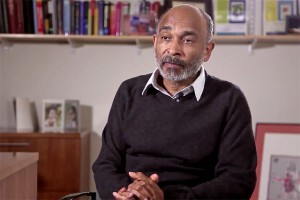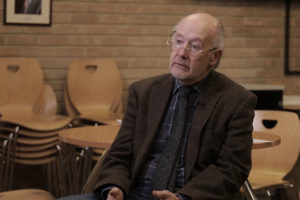Propofol as a Widely Used Anesthetic
Neuroscientist Emery Brown on anesthetics' oscillation, propofol, and anesthesiology as a part of clinical neu...

One of the most difficult problems in conducting this research is how to define bilingualism. Contrary to almost everything else that is studied in psychology, bilingualism is not a dichotomy: one is not one or the other, and one is not monolingual or bilingual. Everyone has some kind of experience with different languages, so the first problem that has to be dealt with in the research on bilingualism is how to define the populations for a particular study. There are two approaches: in some studies, there is a criterion like a ‘person who has spoken two languages on a regular basis for most of their lives with high fluency is bilingual,’ and people who maybe have less proficiency and so forth are essentially monolingual. Using that approach, the researchers usually end up with two groups, but they need to exclude people who are ambiguous and end up excluding a lot of people because it is not clear if they are monolingual or bilingual.
The second approach is to say ‘bilingualism is actually a continuum’. In our research, we have a rather detailed questionnaire that we give to the participants in which they answer lots of questions about their language proficiency, their language use, who speaks what to whom in their homes, and so forth. On the basis of that information, participants are given a score – a bilingualism score – where a higher score means ‘more bilingual’. Using this approach, it is not necessary to divide people into groups but just say that there is a ‘range of bilingualism’.
The research with children and cognition has been around for a long time, mostly focused on studies of children and language abilities, children and literacy abilities, but the paper in 2004 by Ellen Bialystok and her colleagues was the first that looked at this question with adults.
The early research on children was poorly done – it was not well controlled, it was poorly designed, and it had many other problems. This research through the 30s, 40s, and 50s tended to show that bilingual children were really disadvantaged; they did poorly in school, had terrible test results, and so on. The popular conclusion from these early studies, and in fact, what the researchers actually said in their articles – was that ‘bilingualism causes retardation’, and ‘bilingualism confuses children’. The first decent study, a well-designed study that showed positive results for bilingualism, was published in 1962. Peal and Lambert conducted a study in Montreal comparing French-English bilingual children with French monolingual children. They wanted to design the study properly and show that bilingualism was not damaging children. They predicted that if they designed this study carefully, bilingual children would perform the same as monolingual children on non-verbal tasks but worse than monolingual children on verbal tasks. Contrary to the initial predictions, what they found was that bilingual children were just better at everything. So it was the first time there were positive effects of bilingualism in that study was reasonably well-controlled – not perfectly, but reasonably.
Through the 1990s, the Bialystok group and other researchers started looking at bilingual consequences for children inspired by the Peal and Lambert research in order to see the conditions under which the Peal and Lambert results could be replicated, to see if it could be shown in different groups and other conditions. These studies showed that on both linguistic and cognitive tests, bilingual children consistently showed these kinds of benefits over monolingual children.
To push the research further, it was important to know how these effects carry on in the long term. The research was primarily on children who were 4, 5, or 6 years old on very simple cognitive tests. All children are going to be performing perfectly on these cognitive tasks in a very short time. So if one waits another year, the monolingual children have just as good results. And one could say: so what is the point? The bilingual children just do it a little bit earlier. It is not that important if everybody gets there. What would be important would be if one could find some sustained impact on cognitive performance across the entire lifespan.
The aforementioned 2004 study was the first one to investigate that question in adults, and it was found that on these non-verbal cognitive tasks, bilingual adults outperformed monolingual adults.
Since then, the research has expanded enormously, so there is a huge variety of studies. The research with behavioral studies has grown to include many different kinds of tasks. Importantly, the impact of bilingualism is only found in some kinds of tasks. That makes sense; nobody ever said that bilingualism is going to make someone smarter, better at everything, more able, or more talented in certain ways. Instead, the impact is very precise, and there is a good sense now about what that impact is. Behavioral research is currently aimed at investigating what kinds of tests show these differences in performance.
On top of that, there is now growing research on the neurological bases of these effects. There are quite a lot of neuroimaging studies now looking for how monolingual and bilingual brains are different structurally and functionally. That is, what is it that’s affected in the brain by the experience of bilingualism?
The problem with this line of research is that these are very simple tests that young adults are performing extremely well: they are very fast, they make no errors, and so on. Thus it seems to be not a sensitive enough measure to figure out what is different in the minds of monolinguals and bilinguals. The conclusion is not that there are no differences between monolinguals and bilinguals but rather that this is not an appropriate means of investigating the question, at least for young adults. The tests are not sensitive enough to find the differences.
In contrast, if one takes these same populations and adds some form of neuroimaging – electrophysiology, fMRI, or something else of this kind, it will reveal that their brains are different and they are using their brains differently while performing these tasks. That is, even though the performance is the same, their brains are different. So it is very important that you use measures and methods that are going to pick up the differences between monolinguals and bilinguals.
And finally, there is a smaller but growing type of research that is looking at patients that tries to answer the question of whether bilingualism still has an effect on cognition when there is a neurodegenerative disease or stroke, for example. These studies have led to exciting and novel results.
Language acquisition in bilinguals is a complicated question. It seems that when a child is being raised in a home where two languages are spoken, there is no impact on the acquisition of both languages – they learn both languages perfectly normally, perfectly fluently. However, it is known that, on average, the vocabulary of a bilingual is generally smaller than the vocabulary of a monolingual speaker of each language. But then, the bilingual speaker has two languages, so it is scarcely a hardship. So if two languages are presented to the children at home, there is no problem – children will learn them. In a couple of neuroimaging studies that have been conducted on children, the results are comparable to adults.
There is no difference in cognitive ability in the sense of general intelligence – so bilinguals are not smarter than monolinguals. But the difference between monolingual and bilingual cognition is in specific processes concerned with attention and selection. It is the ability to selectively attend to relevant information when there is a distraction that is better in bilinguals. And that is not trivial because that is the basis of a lot of higher-order thinking and performing. So if one is driving on a highway at high speed – there are a lot of things on your mind: there is a route, an exit you’re watching for, the signs – there is a need to keep a lot of things in mind and watch the signs. You need to be able to focus your attention in very careful ways. That is the kind of thing that bilinguals are doing better. These processes of holding information in mind while you’re performing a task and selecting which information to pay attention to are part of the executive function system.
The explanation given by Ellen Bialystok is that if a person is bilingual, if he or she has two languages that are used regularly, both of these languages are always active in mind, and that means that there is always a conflict that requires a mechanism to select the correct language. So the interpretation is that the executive function system is used to selectively attend to the language that currently needs to be used, and this is exactly the process that is at the bottom of all the cognitive tasks on which bilinguals are performing better.
Some of the studies do not put people into groups but instead give each participant a bilingualism score. Typically people who are more bilingual show better results than people who are less bilingual. In this case, people who have been bilingual for a longer time would show larger effects than people who have been bilingual for a shorter time. And perhaps, that is because that is all caused by this ongoing experience – these are dose-related effects. It is hardly that simple because there are many things involved, but in general – the more – the better.
One finding in the bilingual aging research that has been replicated a few times now is that in patients who have been diagnosed with dementia, in particular, Alzheimer’s disease, the first appearance of the symptoms that led to that diagnosis was later for bilinguals. It is known from brain research in these patients that the disease is there, and it is beginning to affect their brains. However, these bilingual patients can carry on functioning apparently normally for a longer time. It appears that they are compensating. This is a rather dramatic finding and has been replicated a number of times.
Many kinds of tests have been conducted on such patients; it has been studied very thoroughly – we collected information about their cognitive level, their IQ level, their brains, and so on. And what we conclude from these studies is that they are afflicted with the disease. For example, Alzheimer’s disease first affects the middle part of the brain, the memory sector – hippocampus – and from looking at their brains, it seems that bilingual patients are more affected by the disease than monolingual patients when they are functioning at the same level, but they have been able to carry on functioning longer.
A recent study from the group at the University of Edinburgh looked at patients with strokes. This was a large sample of monolingual and bilingual stroke patients. What they were able to do was to track their cognitive recovery after the stroke and found that twice as many bilingual patients were able to restore full cognitive level compared to monolingual patients. The numbers were dramatic – 40% of bilingual patients and 20% of monolingual patients showed cognitive recovery after stroke.
What seems to be happening with bilingualism is that it is contributing to this notion that people call ‘cognitive reserve’. We know that there are a lot of things that a person can do in life to help maintain cognitive function – do crossword puzzles, participate in social groups, attend lectures, and so forth. These activities provide brain stimulation to maintain cognitive function, and bilingualism may be just another factor that contributes to cognitive reserve.
Because being bilingual makes language processing more complex because a bilingual person always has these two languages to select between – that situation provides constant brain stimulation that slows aging. Hence bilingualism is acting in the same way as formal education and all of these other things that have been shown to contribute to this cognitive reserve and therefore protect cognition.
An array of studies also tried to include trilinguals and multilinguals – people who speak three or more languages. However, with them, it is harder to be sure that nothing else is different. When we compare monolinguals and bilinguals, we are very careful to be sure that, as far as we are able, nothing else is different between these groups. If you then include trilinguals and multilinguals, many other things are going to be different. For example, many people become multilingual because they are more talented, more educated, or have more motivation to learn languages. And all these differences themselves might affect these scores. Despite this, there are a few studies with children that found no difference between multilinguals and bilinguals. There are also some studies on this question with older adults, even with patients. Some of those studies show that the more languages older adults speak, the more protection they have, so there was an incremental effect. But those results are tentative because the studies do not always control for those other factors: were the people who spoke four languages instead of two languages also more educated and more intelligent? This question remained unanswered.
These are still very early days of this kind of research and there are many unresolved questions. One question the researchers are working on now is getting a more accurate sense of what the mechanism is, and what exactly is different in bilingual and monolingual minds. Currently, imaging studies are being conducted trying to figure out – why, how, and with what consequences bilingualism changes minds in these ways. These are not yet resolved questions, but there is a reasonable idea of where to look for the answers yet to be found.
Peal, Elizabeth, & Lambert, Wallace E. (1962). The relation of bilingualism to intelligence. Psychological
Monographs, 76(27, Whole No. 546).
Bialystok, E., & Martin, M.M. (2004). Attention and inhibition in bilingual children: Evidence from the dimensional change card sort task. Developmental Science, 7, 325-339.
Edited by Ksenia Vinogradova

Neuroscientist Emery Brown on anesthetics' oscillation, propofol, and anesthesiology as a part of clinical neu...

Psychologist Terry Hanley on the history of distant counselling, the outcomes of the online therapy and the ne...

Psychiatrist Guy Goodwin on the monoamine theory of depression, cognitive behaviour therapy and why some peopl...